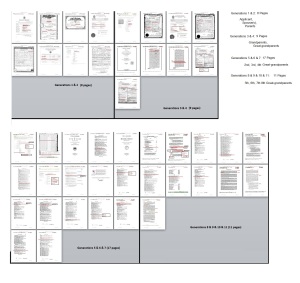Earlier posts dealt with technical issues (configuration vs content) and general matters (content vs its management). These are not the same. Now, we are venturing into operational issues that stump the practitioner.
Yet, many have worked out their process (see Hereditary Society membership, 2nd bullet). For the most part, these age-old techniques have ended up with information being duplicated, redundantly, in a manner that spawns what looks like a mess. For one, any of these point-in-time methods for storage will result in erroneous data. Case in point? Take an application at time 0. Let’s say the person, later, loses a spouse and remarries. Is the application updated? Or, suppose that later research shows some earlier information to be wrong. Are the applications updated? There will be some time after 0 when the information will be stale. That is the reality of computing.
So, in some cases, ramifications of new bits of data being available may even invalidate an application. What to do? Well, firstly, let’s all agree that it is a difficult situation. However, at the same time, genealogy ought to be vigilant in keeping processes up to date and effective. How so?
Well, we are discussing that. — So, before proceeding, let’s look at a case or two of recent experience. The situation involves a three-year stint where over fifteen applications were submitted and accepted (genealogically; in one cases, there were differences of opinion with regard to the ancestor’s suitability — in others, the proof of the application was considered sufficient, so why join? – as in, being verified by an independent party).
As well, the first application was with D.A.R. during which experience there was a trained genealogist helping with the structure. The leg-work was performed by the researcher (for the applicant). That effort was followed up, later, by supplemental applications to D.A.R. For the most part, applications have used a different ancestor and part of the tree (the goal was to verify main branches). The D.A.R. experience was sufficient to allow other the researcher to work all other applications. The researcher took no genealogy courses; rather, the researcher has years of experience of research and modeling (in an advanced computing context across a wide spectrum of domains).
So, the idea is to do this work, allow results to undergo scrutiny and, then, describe the experience (pending – see R.C. Anderson’s take on methods).
Now, the image, below, is a snap from the Word files that were used to print an application’s supporting material. That is, the application form (which can vary quite a bit between organizations) is not shown. The pages are marked source material that cogently links generations back to the 11th.
Again, let’s stop and consider the evaluation of this material. The expert who reviewed the application and the supporting material said that it was one of the best that the person had seen. At some point, this details of this application will appear at the Thomas Gardner Society, Inc. site. The research effort for this application resulted in two articles that were published by the TEG (Vol 34 – see The Gardner Annals Vol 1, No 2).  The image has four groups. On the upper left is the material for Generations 1 & 2. Then, we have material for Generations 3 & 4. On the lower part, we have the generations that are further removed. That first group consisted of 8 pages. Then, the second group had another 9. The other groups had 28 pages.
The image has four groups. On the upper left is the material for Generations 1 & 2. Then, we have material for Generations 3 & 4. On the lower part, we have the generations that are further removed. That first group consisted of 8 pages. Then, the second group had another 9. The other groups had 28 pages.
What we need to discuss in terms of modern handling are Groups 1 and 2. These are both semi-static, in nature. Group 2 is especially so, after deaths are recorded. However, both of these groups deal with sensitive information. That is, as technology rolls forward, we know more and more about a person. Query: why does a heritage society need to know the details of someone’s death – voyeurism? Hence, besides the issue of privacy, we see that Groups 1 and 2 are duplicated between applications (and, we’re sensitive to that due to shipping off packets of mostly duplicated material many times over in a short time frame). Group 2 may differ by whether the applicant is using the paternal or maternal tree, however the information is mostly static.
How might Groups 1 and 2 be handled in a more private, robust, and effective manner?
At the moment, the Thomas Gardner Society, Inc. is preparing a process for handling membership applications. This question is central to that process which will be defined here. Prior to that, let’s look at other examples which will be linked to this post.